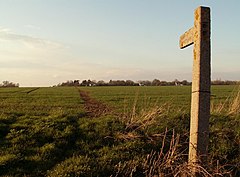Matching, Essex
| Matching | |
|---|---|
 St. Mary the Virgin Church and Wedding Feasting House |
|
 Public footpath to Housham Tye from New Way Lane, near the parish centre |
|
| Matching shown within Essex | |
| Population | 635 (2001) 661 (2011) |
| Civil parish |
|
| District | |
| Shire county | |
| Region | |
| Country | England |
| Sovereign state | United Kingdom |
| Post town | HARLOW |
| Postcode district | CM17 |
| Dialling code | 01279 |
| Police | Essex |
| Fire | Essex |
| Ambulance | East of England |
| EU Parliament | East of England |
| UK Parliament | |
Matching is a village and civil parish in the Epping Forest district of Essex, England centred in countryside 3 miles (4.8 km) east of Harlow's modern town centre and 2 miles (3.2 km) from Old Harlow/Harlow Mills area of the town. The terrain is elevated and London is centred 21.7 miles (34.9 km) to the southwest.
Matching's name is of Saxon origin, derived from the people or tribe of Maecca (Match) who settled in an open area of pasture called an "Ing", hence 'Matching'. In the Domesday Book (1086) it was called Matcinga.
All its Domesday manors were fertile but small and poor — the three small manors held by the Abbey of St Valery, Geoffrey de Mandeville, and Ralph de Tony each had a single ploughteam in 1066. Matching from the mid-medieval period had four manor houses, which now stand on or near their medieval sites.
Matching Hall is one of the four and one of three Grade II* architecture buildings in the old village centre, which is dominated by the church and is a cul-de-sac also accessible by footpaths. Richard de Montfichet held the manor in 1260.
Housham Hall is timber-framed but encased in brick in the 18th century and was William de Warenne's in 1086, one of two manors in the feudal system recorded as "Ovesham" in the Domesday Book. Its more formal manor house, indicating 17th century wealth in the estate, Housham Tye, dates from the 17th century but was greatly enlarged in the 19th and the early 20th century. The Hall's free chapel had remains visible in 1720 south of the moat.
Parvills Farm anciently "Parvilles" may have originated as a free tenement of Matching Hall manor and was in the 13th century held by the Pereville (later Parvill) family — Agnes de Pereville gifted part of the land 50 acres (20 ha) of land in Matching to her son, Peter of Wakering. In 1341 it was held by this family of local landlord Maurice de Berkeley. In 1624 Parvills belonged to Edward Covell. In the 1840s Parvills farm, comprising 32 acres (13 ha) in Matching and 41 acres (17 ha) in Hatfield Broad Oak, was owned by the Reverend John Connop. In the later 19th century it was acquired as part of the Down Hall estate, in which it passed until it was sold in 1920 to the Scantlebury family who held it until at least 1982. The old house was used as farm cottages until 1945, when it was demolished after a fire.
...
Wikipedia

